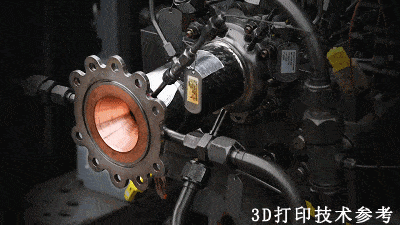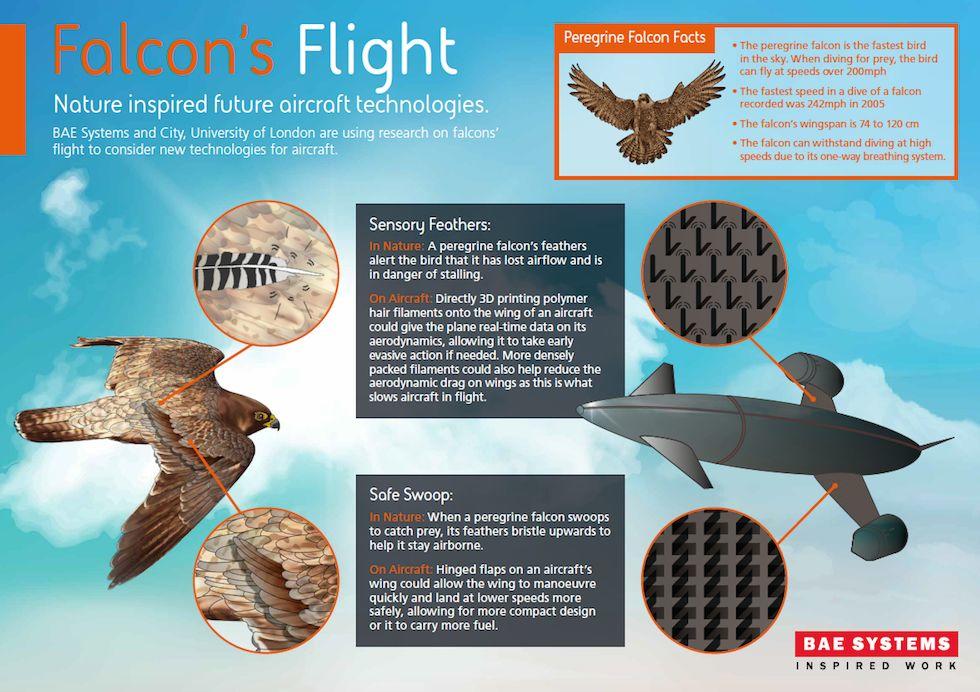Bionic designs often have complex geometric structures, such as honeycomb structures, complex lattice structures, fiber angle and direction variable structures, curved (wavy) structures, mixed materials, and gradient structures, which are difficult to achieve through traditional manufacturing methods. Additive manufacturing technology can realize various “microstructures” in design, and has unique advantages in realizing bionic design and gradient design. In recent years, the United States and Europe have used additive manufacturing technology to achieve bionic structure design and gradient structure manufacturing, and have achieved many results.
▌ Development bionic “sensor feathers” to improve aircraft performance
The Peregrine falcon is the fastest bird in the world. It can dive and prey at a very steep angle. Its physiological function shows the mechanical properties, which can improve the aerodynamics of the aircraft and improve the safety and fuel efficiency of the aircraft.
In 2017, BAE Systems used additive manufacturing technology to develop a “sensing feather” that can give early warning when the aircraft is in danger of stalling. It can also change the airflow near the surface of the aircraft, effectively reducing the resistance encountered by the wings and improving the aircraft Speed is expected to be used in fighter jets and other weapons in the future. This research will bring real innovation and benefits to the aerospace industry.
▌Development of materials for imitation conch shells for human protection
In 2017, MIT researchers used 3D printing technology to successfully manufacture engineering materials that mimic conch shells, and conducted effective tests. The internal structure of the conch shell is very unique, including three different layers, which makes it difficult for micro-cracks to spread, so it has super durability and fracture resistance, and its toughness can even reach 10 times that of the nacre.


The conch shell engineering material imitated by 3D printing technology has a crack propagation resistance 1.85 times that of the strongest base material and 1.7 times that of traditional fiber composite materials. It is very suitable for the preparation of impact-resistant protective helmets or human armor. The researchers said that this material has a zigzag matrix, and it is difficult to propagate cracks. It is difficult to imitate this material using traditional methods.
▌Using additive manufacturing to realize deformable software robot
Under the stimulation of light, heat, solvent, electric field, and magnetic field, soft materials capable of three-dimensional shape transformation have been used in various fields, such as flexible electronic devices, new flexible robots, and biomedicine.
The US Army is based on elastomer composites containing ferromagnetic particles, and programs information on structure, magnetic domains, and magnetic fields to realize the complex shape changes of robots, thereby completing “actions” such as crawling, rolling, jumping, or grabbing. The Army needs research in robotics and autonomous systems.
▌Realize the ignition device of multi-metal hybrid rocket engine
The conventional rocket engine ignition device will be manufactured using a brazing process, which is both time-consuming and expensive. The manufacturing process can take months or even longer, and it can easily lead to different quality levels of different components. High manufacturing costs and long waiting times have made space launches increasingly more focused on additive manufacturing.

Using 3D printing to manufacture engine ignition devices with complex cooling channels can meet the requirements of complex design, low cost and fast delivery. In September 2017, NASA successfully tested the first rocket engine igniter made of Inconel and copper alloy 3D printing, breaking through the technical bottleneck of multi-metal additive manufacturing components.
END
At present, this application direction mainly carries out key technical researches such as intelligent bionic structural design, 3D functional gradient material development, gradient structure additive manufacturing, and multiple material integration. In the future, there will be a large number of new weapons and equipment designed with bionic structures and gradient structures, such as bionic aircraft, bionic submarines, and bionic software robots. With the development of new materials and the development of multi-material integration technology, additive manufacturing technology will play an increasingly important role in spawning new concept weapons and equipment.


